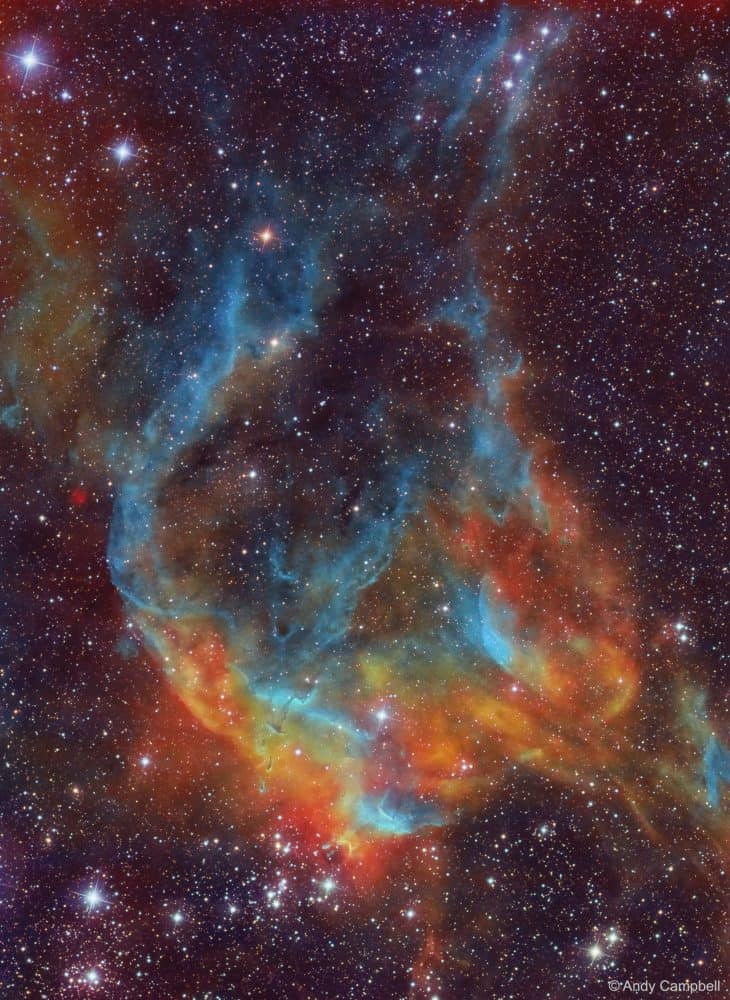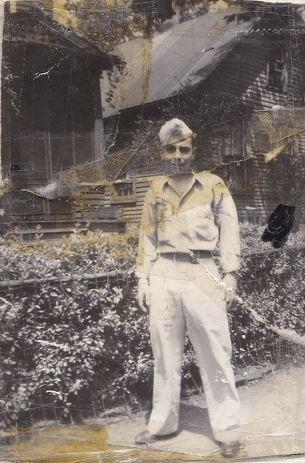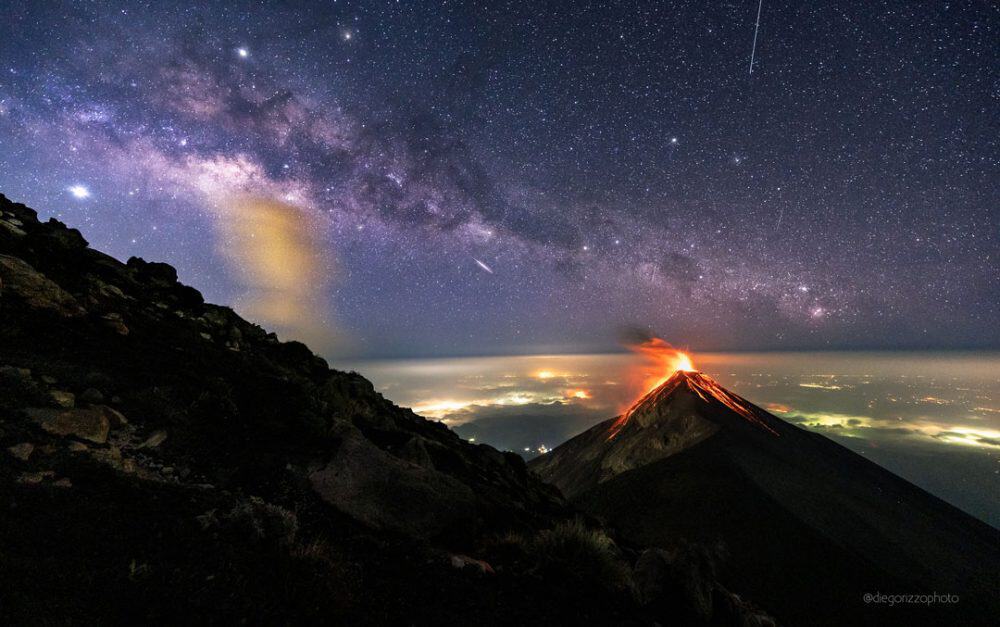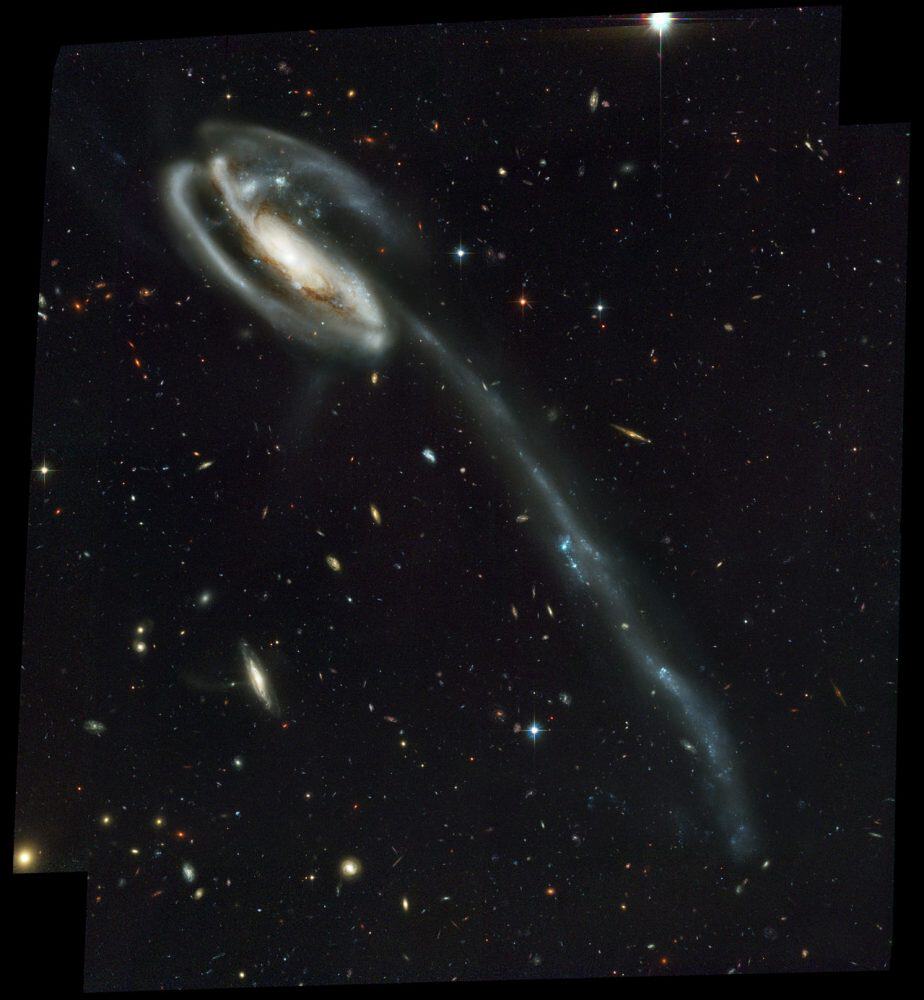Blog
This chromatic cosmic portrait features glowing gas and dark dust near some recently formed stars of NGC 3572, a little-studied star cluster near the Carina Nebula. Stars from NGC 3572 are visible near the bottom of the image, while the expansive gas cloud above is likely what remains of their formation nebula. The image‘s striking hues were created by featuring specific colors emitted by hydrogen, oxygen, and sulfur, and blending them with images recorded through broadband filters in red, green, and blue. This nebula near NGC 3572 spans about 100 light years and lies about 9,000 light years away toward the southern constellation of the Ship’s Keel (Carina). Within a few million years the pictured gas will likely disperse, while gravitational encounters will likely disperse the cluster stars over about a billion years.
more...Leland Bruce Sklar (born May 28, 1947) is an American electric bass guitarist and session musician. He is a member of the Los Angeles-based instrumental group The Section, who served as the de facto house band of Asylum Records and were one of the progenitors of the soft rock sound prevalent on top-40 radio in the 1970s and 1980s. Besides appearing as the backing band on numerous recordings by artists such as Jackson Browne, Carole King, and James Taylor, the Section also released three solo albums of instrumental rock. Both in The Section and separately, Sklar has contributed to over 2,000 albums as a session musician. He also has toured extensively with major rock and pop acts, and recorded many soundtracks to films and television shows.
Sklar studied at California State University, Northridge. It was during that time he met James Taylor, who invited him to play bass at some venues. They both thought that the work would be short-term, but soon Taylor’s career took off with his first hit records, and Sklar came into the limelight. He was soon asked to record with others, and his long career began. In the 1970s, Sklar worked so frequently with drummer Russ Kunkel, guitaristDanny Kortchmar, and keyboardist Craig Doerge that they eventually became known as “The Section” and recorded three albums under that name between 1972 and 1977.
more...
Aaron Thibeaux “T-Bone” Walker (May 28, 1910 – March 16, 1975) was an American blues guitarist, singer, songwriter and multi-instrumentalist, who was a pioneer and innovator of the jump blues and electric bluessound. In 2018 Rolling Stone magazine ranked him number 37 on its list of “The 100 Greatest Guitarists of All Time”. Walker was born in Linden, Texas, of African-American and Cherokee descent. His parents, Movelia Jimerson and Rance Walker, were both musicians. His stepfather, Marco Washington, taught him to play the guitar, ukulele, banjo, violin, mandolin, and piano.
In 1942, Charlie Glenn, the owner of the Rhumboogie Café, brought T-Bone Walker to Chicago for long-time stints in his club. In 1944 and 1945, Walker recorded for the Rhumboogie label, which was tied to the club, backed up by Marl Young‘s orchestra.
T-Bone Walker performed at the second famed Cavalcade of Jazz concert held at Wrigley Field in Los Angeles produced by Leon Hefflin Sr. on October 12, 1946. Jack McVea, Slim Gaillard, The Honeydrippers, Lionel Hampton and his Orchestra, and Louis Armstrong were all on the same program. He also performed for the third Cavalcade of Jazz concert held in the same location on September 7, 1947 along with Woody Herman as Emcee, The Valdez Orchestra, The Blenders, The Honeydrippers, Slim Gaillard, Johnny Otis and his Orchestra, Toni Harper, The 3 Blazers and Sarah Vaughn.
Much of his output was recorded from 1946 to 1948 for Black & White Records, including his most famous song, “Call It Stormy Monday (But Tuesday Is Just as Bad)” (1947). Other notable songs he recorded during this period were “Bobby Sox Blues” (a number 3 R&B hit in 1947) and “West Side Baby” (number 8 on the R&B singles chart in 1948).
Andrew Dewey Kirk (May 28, 1898 – December 11, 1992) was a jazz saxophonist and tubist who led the Twelve Clouds of Joy, a band popular during the swing era.
Kirk grew up in Denver, Colorado, where he was tutored by Wilberforce Whiteman, Paul Whiteman’s father.Kirk started his musical career playing with George Morrison’s band, but then went on to join Terrence Holder‘s Dark Clouds of Joy. In 1929 he was elected leader after Holder departed. Renaming the band Clouds of Joy, Kirk also relocated the band from Dallas, Texas, to Kansas City, Missouri. Although named the Clouds of Joy, the band has also been known as the Twelve Clouds of Joy due to the number of musicians in the band. They set up in the Pla-Mor Ballroom on the junction of 32nd and Main in Kansas City and made their first recording for Brunswick Records that same year. Mary Lou Williams came in as pianist at the last moment, but she impressed Brunswick’s Dave Kapp, so she became a member of the band.
Kirk moved the band to Kansas City, and since their first recordings in 1929–1930, they grew popular as they epitomized the Kansas City jazz sound. In mid-1936, he was signed to Decca and made scores of popular records until 1946.
https://www.youtube.com/watch?v=lF_o8O4ANL4
more...https://www.youtube.com/watch?v=ZXLEBzdpdF0
more...https://www.youtube.com/watch?v=KQPyk4OUkeA&list=PLEB3LPVcGcWZ0hsQ5_jgSMhawAnDzy1io&index=2&t=0s
more...My dad Mike LaBriola as a teenager and soldier during WWII. He was stationed in Italy his place of birth. Now fighting the Nazi/Mussolini occupation as an American soldier. Pictured here in Blue Island, Ill
more...Volcan de Fuego is an active stratovolcano in Guatemala, on the borders of Chimaltenango, Escuintla and Sacatepéquez departments. It sits about 16 kilometres (9.9 mi) west of Antigua, On the land of the featured image, for example, the Volcano of Fire (Volcán de Fuego) is seen erupting topped by red-hot, wind-blown ash and with streams of glowing lava running down its side. Lights from neighboring towns are seen through a thin haze below. In the sky, though, the central plane of our Milky Way Galaxy runs diagonally from the upper left, with a fleeting meteor just below, and the trail of a satellite to the upper right. The planet Jupiter also appears toward the upper left, with the bright star Antares just to its right. Much of the land and the sky were captured together in a single, well-timed, 25-second exposure taken in mid-April from the side of Fuego‘s sister volcano Acatenango in Guatemala. The image of the meteor, though, was captured in a similar frame taken about 30 minutes earlier — when the volanic eruption was not as photogenic — and added later digitally.
more...Dee Dee Bridgewater (née Denise Garrett, May 27, 1950) is an American jazz singer. She is a three-time Grammy Award-winning singer-songwriter, as well as a Tony Award-winning stage actress. For 23 years, she was the host of National Public Radio’s syndicated radio show JazzSet with Dee Dee Bridgewater. She is a United Nations Goodwill Ambassador for the Food and Agriculture Organization.
Born Denise Eileen Garrett in Memphis, Tennessee, she was raised Catholic in Flint, Michigan. Her father, Matthew Garrett, was a jazz trumpeter and teacher at Manassas High School, and through his playing, she was exposed to jazz early on. At the age of sixteen, she was a member of a Rock and Rhythm ‘n’ Blues trio, singing in clubs in Michigan. At 18, she studied at Michigan State University before she went to the University of Illinois at Urbana-Champaign. With the school’s jazz band, she toured the Soviet Union in 1969.
The next year, she met trumpeter Cecil Bridgewater, and after their marriage, they moved to New York City, where Cecil played in Horace Silver‘s band. In the early 1970s, Bridgewater joined the Thad Jones-Mel Lewis Jazz Orchestra as lead vocalist. This marked the beginning of her jazz career, and she performed with many of the great jazz musicians of the time, such as Sonny Rollins, Dizzy Gillespie, Dexter Gordon, Max Roach, Rahsaan Roland Kirk and others. She performed at the Monterey Jazz Festival in 1973. In 1974, her first solo album, entitled Afro Blue, appeared, and she performed on Broadway in the musical The Wiz. For her role as Glinda the Good Witch she won a Tony Award in 1975 as “Best Featured Actress”, and the musical also won the 1976 Grammy Award for Best Musical Show Album.
more...Niels-Henning Ørsted Pedersen (Danish pronunciation: [nelsˈhɛneŋ ˈɶɐ̯stəð ˈpʰɛðɐsn̩], 27 May 1946 – 19 April 2005), often known as NHØP, was a Danish jazz upright bassist known for his technique and musical approach.
Ørsted Pedersen was born in Osted, near Roskilde, on the Danish island of Zealand, the son of a church organist. As a child, Ørsted Pedersen played piano, but from the age of 13, he started learning to play upright bass and at the age of 14, while studying, he began his professional jazz career in Denmark with his first band, Jazzkvintet 60 (Danish for Jazz Quintet 60). By the age of fifteen, he had the ability to accompany leading musicians at nightclubs, working regularly at Copenhagen’s Jazzhus Montmartre, after his debut there on New Year’s Eve 1961, when he was only 15. When seventeen, he had already turned down an offer to join the Count Basie orchestra, mainly because he was too young to get legal permission to live and work as a musician in the United States.
The Montmartre was a regular stop-off for touring American Jazz stars, and as a member of the house band, the young Ørsted Pedersen performed with saxophonists such as Sonny Rollins, Dexter Gordon, Rahsaan Roland Kirk and Stan Getz, and pianist Bill Evans, with whom he toured in Europe in 1965. During the 1960s, Ørsted Pedersen played with a series of other important American jazzmen who were touring or resident in Denmark, including Ben Webster, Brew Moore, Bud Powell, Count Basie, Roy Eldridge, Dizzy Gillespie, Jackie McLean, and vocalist Ella Fitzgerald. He also played with Jean-Luc Ponty, and became the bassist of choice whenever a big-name musician was touring Copenhagen.
https://www.youtube.com/watch?v=vZrQIn23018
more...Clifford Everett “Bud” Shank, Jr. (May 27, 1926 – April 2, 2009) was an American alto saxophonist and flautist. He rose to prominence in the early 1950s playing lead alto and flute in Stan Kenton‘s Innovations in Modern Music Orchestra and throughout the decade worked in various small jazz combos. He spent the 1960s as a first-call studio musician in Hollywood. In the 1970s and 1980s, he performed regularly with the L. A. Four. Shank ultimately abandoned the flute to focus exclusively on playing jazz on the alto saxophone. He also recorded on tenor and baritone sax. He is also well known for the alto flute solo on the song “California Dreamin’” recorded by The Mamas & the Papas in 1965.
Bud Shank was born in Dayton, Ohio. He began with clarinet in Vandalia, Ohio, but had switched to saxophone before attending the University of North Carolina. While at UNC, Shank was initiated into the Pi Kappa Alpha Fraternity. In 1946 he worked with Charlie Barnet before moving on to Kenton and the West coast jazz scene. He also had a strong interest in what might now be termed world music, playing Brazilian-influenced jazz with Laurindo Almeida in 1953–54.
more...A colliding galaxy dubbed the “Tadpole” (catalog name UGC10214) is set against a rich tapestry of 6,000 galaxies. The Tadpole, with its long tail of stars, looks like a runaway pinwheel firework, unlike the textbook images of stately spiral galaxies. Its distorted shape was caused by a small interloper, a very blue, compact galaxy visible near the more massive Tadpole. The Tadpole resides about 420 million light-years away in the constellation Draco. Seen shining through the Tadpole’s disk, the tiny intruder is likely a hit-and-run galaxy that is now leaving the scene of the accident. Strong gravitational forces from the interaction created the long tail of debris, consisting of stars and gas that stretch out more than 280,000 light-years.
more...Stephanie Lynn “Stevie” Nicks (born May 26, 1948 Phoenix, AZ) is an American singer and songwriter. Nicks is best known for her work as a songwriter and vocalist with Fleetwood Mac, and also for her chart-topping solo career. She is known for her distinctive voice, mystical stage persona and poetic, symbolic lyrics. Collectively, her work both as a member of Fleetwood Mac and as a solo artist has produced over forty top 50 hits and sold over 140 million records, making her one of the best-selling music acts of all time with Fleetwood Mac.
Nicks joined Fleetwood Mac in 1975 along with her then boyfriend, Lindsey Buckingham. Rumours, Fleetwood Mac’s second album after the incorporation of Nicks and Buckingham, was the best-selling album of the year of its release and to date has sold over 40 million copies worldwide, making it the fifth biggest-selling studio album of all time. The album remained at number one on the American albums chart for 31 weeks and reached number one in various countries worldwide. The album won the Grammy Award for Album of the Year in 1978. It produced four US Billboard Hot 100top-ten singles, with Nicks’s “Dreams” being the band’s first and only Billboard Hot 100 number-one hit.
In 1981, while remaining a member of Fleetwood Mac, Nicks began her solo career, releasing the studio album Bella Donna, which topped the Billboard 200 and has reached multiplatinum status.[3] She has released a total of eight solo studio albums to date, with her most recent, titled 24 Karat Gold: Songs from the Vault, released in October 2014.
more...Mark Lavon “Levon” Helm (May 26, 1940 – April 19, 2012) was an American musician and actor who achieved fame as the drummer and one of the vocalists for the Band. Helm was known for his deeply soulful, country-accented voice, multi-instrumental ability, and creative drumming style, highlighted on many of the Band’s recordings, such as “The Weight“, “Up on Cripple Creek“, and “The Night They Drove Old Dixie Down“.
Helm also had a successful career as a film actor, appearing as Loretta Lynn‘s father in Coal Miner’s Daughter, as Chuck Yeager‘s friend and colleague Captain Jack Ridley in The Right Stuff, and as a Tennessee firearms expert in Shooter.
In 1998, Helm was diagnosed with throat cancer, which caused him to lose his singing voice. After treatment, his cancer eventually went into remission, and he gradually regained the use of his voice. His 2007 comeback album Dirt Farmer earned the Grammy Award for Best Traditional Folk Album in February 2008, and in November of that year, Rolling Stone magazine ranked him No. 91 in its list of 100 Greatest Singers of All Time. In 2010, Electric Dirt, his 2009 follow-up to Dirt Farmer, won the first Grammy Award for Best Americana Album, a category inaugurated in 2010. In 2011, his live album Ramble at the Ryman won the Grammy in the same category. On April 17, 2012, his wife and daughter announced on Helm’s website that he was “in the final stages of his battle with cancer” and thanked fans while requesting prayers. Two days later, Helm died at Memorial Sloan-Kettering Cancer Center in New York City.
more...Miles Dewey Davis III (May 26, 1926 – September 28, 1991) was an American jazz trumpeter, bandleader, and composer. He is among the most influential and acclaimed figures in the history of jazz and 20th century music. Davis adopted a variety of musical directions in a five-decade career that kept him at the forefront of many major stylistic developments in jazz.
Born and raised in Alton, Illinois, Davis left to study at the Juilliard School in New York City, before dropping out and making his professional debut as a member of saxophonist Charlie Parker‘s bebop quintet from 1944 to 1948. Shortly after, he recorded the Birth of the Cool sessions for Capitol Records, which were instrumental to the development of cool jazz. In the early 1950s, Miles Davis recorded some of the earliest hard bop music while on Prestige Records but did so haphazardly due to a heroin addiction. After a widely acclaimed comeback performance at the Newport Jazz Festivalin 1955, he signed a long-term contract with Columbia Records and recorded the 1957 album ‘Round About Midnight. It was his first work with saxophonist John Coltrane and bassist Paul Chambers, key members of the sextet he led into the early 1960s. During this period, he alternated between orchestral jazz collaborations with arranger Gil Evans, such as the Spanish-influenced Sketches of Spain (1960), and band recordings, such as Milestones (1958) and Kind of Blue (1959). The latter recording remains one of the most popular jazz albums of all time, having sold over four million copies in the U.S.
Davis made several line-up changes while recording Someday My Prince Will Come (1961), his 1961 Blackhawk concerts, and Seven Steps to Heaven (1963), another mainstream success that introduced bassist Ron Carter, pianist Herbie Hancock, and drummer Tony Williams. After adding saxophonist Wayne Shorter to his new quintet in 1964, Davis led them on a series of more abstract recordings often composed by the band members, helping pioneer the post-bop genre with albums such as E.S.P (1965) and Miles Smiles (1967), before transitioning into his electric period. During the 1970s, he experimented with rock, funk, African rhythms, emerging electronic music technology, and an ever-changing line-up of musicians, including keyboardist Joe Zawinul, drummer Al Foster, and guitarist John McLaughlin. This period, beginning with Davis’ 1969 studio album In a Silent Way and concluding with the 1975 concert recording Agharta, was the most controversial in his career, alienating and challenging many in jazz. His million-selling 1970 record Bitches Brew helped spark a resurgence in the genre’s commercial popularity with jazz fusion as the decade progressed.
https://www.youtube.com/watch?v=qiL0jDqjlcA
more...Rubén González Fontanills (May 26, 1919 – December 8, 2003) was a Cuban pianist. Together with Lilí Martínez and Peruchín he is said to have “forged the style of modern Cuban piano playing in the 1940s”.
Between the 1940s and his retirement in the 1980s, he played with Cuba’s most successful acts, including Paulina Álvarez, Arsenio Rodríguez, Orquesta América del 55, Orquesta Riverside and Enrique Jorrín. In the 1990s, he came out of retirement to play in the revival ensembles Afro-Cuban All Stars and Buena Vista Social Club, also recording solo material and performing live until 2002.
more...More Posts
- Oscar D’León Day
- Ronnie Mack Day
- Terry Garthwaite Day
- World Music with Tang Liangxing
- Daily Roots with Bushman
- Music for Surviving the Pandemic and Realizing Racial Justice
- The Cosmos with NGC 7513
- Bela Fleck Day
- Arlo Guthrie Day
- Hank Mobley Day
- Blind Boy Fuller Day
- Flamenco Fridays with Jesús de Madrid y Pepe de Almería
- Daily Roots with Coco Tea
- Music for Surviving the Pandemic and Realizing Racial Justice
- The Cosmos with NGC 2775
- Mitch Mitchell Day
- Mercedes Sosa Day
- Frank Wright Day
- Joe Liggins Day
- World Music with Santrofi



